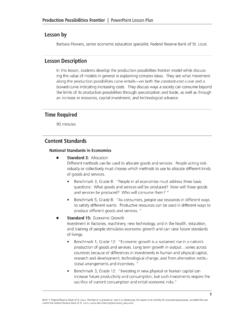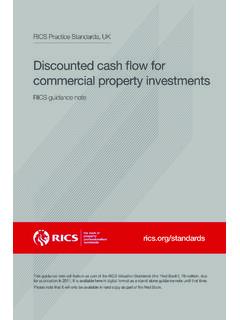Transcription of Is the Fed behind the Curve? Two Interpretations
1 Is the Fed behind the Curve? Two Interpretations James Bullard President and CEO. University of Missouri April 7, 2022. Columbia, Mo. Any opinions expressed here are my own and do not necessarily reflect those of the Federal Open Market Committee. 1. Introduction 2. Key themes inflation is exceptionally high, comparable to that in 1974 and 1983. Standard Taylor-type monetary policy rules, even if based on a minimum interpretation of the persistent component of inflation, still recommend substantial increases in the policy rate. This provides one definition of behind the curve, and the Fed is far behind . However, all is not lost. Modern central banks are more credible than their 1970s counterparts and use forward guidance.
2 Credible forward guidance means market interest rates have increased substantially in advance of tangible Fed action. This provides another definition of behind the curve, and the Fed is not as far behind based on this definition. 3. The Economy Is Still Booming 4. Real GDP growth and labor markets are robust real GDP grew at a rate in 2021.* The most recent forecasts in the Federal Open Market Committee's (FOMC) Summary of Economic Projections suggest real GDP will continue to grow at a slower but still robust pace in 2022, despite an anticipated relatively weak first- quarter reading due to omicron and the Russia-Ukraine war. Labor markets are robust and are likely to improve further in 2022. The unemployment rate has fallen to and will likely fall below 3%.
3 Later this year, an event that has not occurred since the 1950s. This would make the labor market one of the best in the entire post-World War II era. The expansion is not old and can continue for a long time. * Real GDP growth rates are measured as Q4-over-Q4 percentage changes. 5. Labor market conditions are the best in years Source: Federal Reserve Bank of Kansas City. Shaded areas indicate recessions. Last observation: March 2022. 6. Inflation Is Comparable to 1974 and 1983. 7. Core inflation is comparable to 1974 and 1983. One measure of inflation the FOMC uses is core PCE inflation. This measure excludes food and energy components and is also often smoothed by looking at the change from one year earlier. Core PCE inflation from one year earlier is , based on the most recent reading.
4 There have been two other times since 1960 when this measure of inflation has been close to this level. One was 1974, and the other was 1983. 8. Core PCE inflation since 1960. Source: Bureau of Economic Analysis. The gray shaded areas indicate recessions. Last observation: February 2022. 9. Monetary policy in 1974. The 1974 FOMC, which was looking at a core PCE inflation rate similar to today's, liked to talk about nonmonetary factors affecting inflation. The FOMC kept the policy rate relatively low in the face of rising inflation. The associated ex-post real interest rate was relatively low. The subsequent experience was that core PCE inflation was above for nearly 10 years. The real economy was also volatile with multiple recessions.
5 10. Monetary policy in 1983. The 1983 FOMC, which was also looking at a core PCE inflation rate similar to today's, had a different approach to monetary policy and spoke more about monetary factors affecting inflation. The FOMC kept the policy rate relatively high in the face of declining inflation. The associated ex-post real interest rate was relatively high. The subsequent experience was that core PCE inflation was below for the next 10 years. The real economy also stabilized with no recession until 1990-91. The contrast between the 1974 and 1983 experiences convinced many that it was important to avoid getting behind the curve on inflation. 11. First Interpretation of behind the Curve . 12. Interpreting inflation The Fed has a statutory mandate to provide stable prices for the economy.
6 Associated with this mandate is an inflation target of 2%, stated in terms of the headline PCE inflation rate, which was in February measured from one year earlier. Because of particularly large movements in food and energy prices recently, some may argue that the Fed should consider the core PCE. inflation rate instead, which, as we have seen, is currently Still others might argue that the truly persistent factors driving inflation are better captured by the Dallas Fed trimmed mean inflation rate, which was in February measured from one year earlier. 13. Inflation well above target Sources: Bureau of Economic Analysis and Federal Reserve Bank of Dallas. The gray shaded area indicates recession. Last observation: February 2022.
7 14. A generous interpretation In my definitions of behind the curve, I will use the most generous (lowest) interpretation of the persistent component of current inflation, which is the Dallas Fed trimmed mean value. This will help give us a minimal definition of the degree to which the Fed is behind the curve in the calculations in the following slides. We should keep in mind that this minimal definition excludes some inflation that is actually occurring, and that the Fed's inflation target is ultimately stated in terms of headline inflation.. See J. Bullard, Measuring Inflation: The Core Is Rotten, Federal Reserve Bank of St. Louis Review, July/August 2011, 93(4), pp. 223-33. 15. Taylor-type monetary policy rules John Taylor (Stanford University) is famous for developing a Taylor rule which has been widely accepted in monetary policy discussions over the last 30 years.
8 A Taylor-type policy rule with generous assumptions will give us a minimal recommended value for the policy rate given current macroeconomic conditions. We will then compare this minimal recommended rate to the actual policy rate to get a measure of the degree to which monetary policy is behind the curve.. See Taylor, Discretion versus Policy Rules in Practice, Carnegie-Rochester Conference Series on Public Policy, December 1993, 39, pp. 195-214. 16. Ingredients in a Taylor-type rule calculation We need three ingredients in a non-inertial Taylor-type rule calculation:*. 1. A value for the real interest rate ( R-star ); I will use an approximate pre- pandemic value of -50 basis points.. 2. A parameter value describing the reaction of the policymaker to deviations of inflation from target; I will use a relatively low value of 3.
9 A parameter value describing the reaction of the policymaker to deviations of output from potential; I will use zero.. All of these choices can be interpreted as generous that is, as tilting toward a lower recommended policy rate. * Adding inertia would not change the ultimate value of the policy rate but would suggest making a series of policy rate changes. For more on this topic, see J. Bullard, R-Star Wars: The Phantom Menace, Feb. 26, 2018, remarks delivered at the 34th Annual National Association for Business Economics (NABE) Conference in Washington, See the FOMC's Statement on Longer-Run Goals and Monetary Policy Strategy, adopted effective Jan. 24, 2012; as reaffirmed effective Jan. 25, 2022. 17. A behind the curve calculation With these values in a standard non-inertial Taylor-type policy rule, one concludes that the recommended policy rate is + + *( ).
10 = The current value of the policy rate is basis points. One concludes that the current policy rate is too low by about 300 basis points, according to this calculation. This provides one definition of the idea that the Fed is behind the curve.. A higher value for R-star or a broader definition of inflation would suggest considerably higher recommended policy rate values, and the Fed would be further behind the curve. 18. Second Interpretation of behind the Curve . 19. Credibility and forward guidance Modern central banks have considerably more credibility than they did in the 1970s, much of it stemming from an explicit commitment to inflation targeting. They also make more use of forward guidance. As a result, indications of future policy rate increases are incorporated into current financial market pricing, before policy actions are taken.







